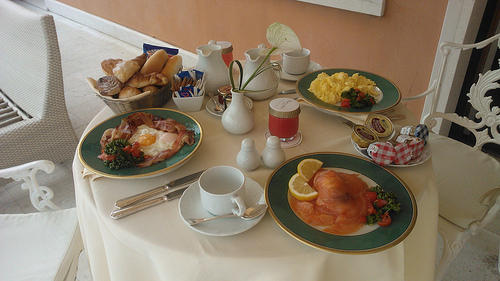Eating out - Lesson 4 - Conversation:
Colazione
(Breakfast)
(photo
by whatleydude used
under terms of Creative Commons license.)

|
Cameriere: |
Buon giorno, Signori. Va bene questa tavola? |
|
Don Smith: |
Quella d'angolo e riservata? |
|
Cameriere: |
No. Prego, da questa parte. Desiderate? |
|
Signora Smith: |
Un'omelette ai funghi. |
|
Don Smith: |
Io vorrei due uova all'occhio di bue con pancetta |
|
Cameriere: |
E da bere? |
|
Signora Smith: |
Un bicchiere di latte freddo per me. |
|
Don Smith: |
Del succo d'arancia. Grazie. |
|
Cameriere: |
Altro? |
|
Don Smith: |
Ci porti delle briosce, del burro, e due caffè. |
|
Signora Smith: |
No, un caffè, Io preferisco un caffelatte. |
|
Don Smith: |
Cameriere, anche della marmellata, per favore. |
|
Cameriere: |
Grazie, Signori. |
Translation:
|
Waiter: |
Good morning, sir, ma'am. Is
this table all right? |
|
Don Smith: |
That one in the corner is
reserved? |
|
Waiter: |
No. Please, this way. What do
you wish? |
|
Mrs. Smith: |
A mushroom omelette. |
|
Don Smith: |
I'd like two eggs sunny-side up
with bacon. |
|
Waiter: |
And to drink? |
|
Mrs. Smith: |
A glass of cold milk for me. |
|
Don Smith: |
Some orange juice. Thank you. |
|
Waiter: |
Something else? |
|
Don Smith: |
Bring us some sweet rolls, some
butter, and two coffees. |
|
Mrs. Smith: |
No, one coffee. I prefer coffee
and milk. |
|
Don Smith: |
Waiter, also some jam, please. |
|
Waiter: |
Thank you, sir, ma'am. |
Notes on conversation
1. In
|
un caffè |
a coffee |
|
un caffelatte |
a coffee with milk |
|
un caffe alla crema OR un caffé alla panna |
a
coffee with cream |
|
un cappuccino* |
an espresso coffee with hot milk or cream |
|
|
some toasted bread |
|
dei panini |
some rolls |
|
dei cornetti, dei croissants |
some croissants |
|
delle briosce |
some sweet rolls |
|
con burro e marmellata
|
with butter and jam |
|
panna |
whipped cream |
*If you want whipped cream on your cappuccino or on anything else, ask for, for example, un cappuccino con panna.
2. Italian bars are cafés. A basic institution of modern life, they range from the luxurious to the merely adequate.
Italians may visit a bar several times a day. They go in the morning for espresso or cappuccino. They go again just before lunch for an aperitivo or another espresso. After lunch they may have a caffè and later in the afternoon another espresso or cappuccino, often drunk with a tramezzino (an English tea sandwich). After work they stop for an aperitivo, and sometimes after dinner they are inclined to drop in for another caffè or whatever.
Italians go alone or with other people. Even though drinks are often consumed standing at a counter instead of sitting at a table, the stop is usually a relaxing pause in a hectic day.
Drinks must be paid for beforehand at the cashier's desk (la cassa). Then the receipt (lo scontrino) is taken to the counter and the order is given to the bartender. It is customary to give a 100- or 150-lire tip or a bit more if several orders have been given. (Tipping also speeds up the service.)
In cities friends meet at bars before they go out for the evening. Inhabitants of small towns spend their evenings there watching television.